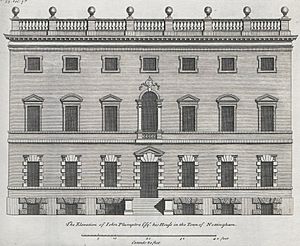John Plumptre (elder) facts for kids
John Plumptre (born around 1680, died 1751) was an important British politician. He lived in Plumptre House in Nottingham. He was a member of the Whig political party. John Plumptre served in the House of Commons, which is like the main parliament, for many years between 1706 and 1751.
Contents
Early Life and Education
John Plumptre was born around 1680 and was baptized on January 16, 1680. He was the oldest son of Henry Plumptre and his second wife, Joyce Sacheverell. In 1693, when he was about 13, he inherited Plumptre House in Nottingham from his father.
He studied law at the Middle Temple starting in 1696. He also attended Queens' College, Cambridge in 1697. Later, he became a Guardian of Plumptre Hospital in 1704. He was also made a "freeman" of Nottingham in 1705. This meant he had special rights in the town. He also helped manage the King Street Chapel.
Political Career
John Plumptre became a Member of Parliament (MP) for Nottingham in 1706. An MP is a person elected to represent an area in the House of Commons, which makes laws for the country.
Early Years in Parliament
In 1708, he was re-elected as a Whig MP for Nottingham. The Whigs were a major political party at the time. He supported a law in 1709 to allow people from Palatine (a region in Germany) to become British citizens. In 1710, he voted to remove Dr. Sacheverell from his position.
He was re-elected again in 1710. He often voted with the Whig party. For example, in 1711, he voted against a peace treaty that did not include Spain. In 1713, he voted against a bill about trade with France. After a powerful supporter, the Duke of Newcastle, died, Plumptre lost some influence in Nottingham. He was not re-elected in 1713.
Return to Parliament and Key Roles
John Plumptre was elected again as MP for Nottingham in 1715. That same year, he was appointed to a special group that dealt with debts from the army. In 1720, he became the Treasurer of the Ordnance. This was an important job where he managed money for military supplies. He held this position for the rest of his life.
He continued to be elected to Parliament:
- In 1722, he was re-elected for Nottingham.
- In 1727, he became MP for Bishop's Castle.
- In 1734, he was re-elected for Nottingham again.
- In 1747, he became MP for St Ives.
He served in Parliament for a very long time, showing his dedication to public service.
Plumptre House Redesign
John Plumptre lived in Plumptre House. He hired a famous architect named Colen Campbell to redesign his home. This work took place between 1724 and 1730.
Later Life and Family
John Plumptre passed away in 1751. He was buried at St Mary's Church in Nottingham. He was married to Annabella Molyneux. She was the daughter of Sir Francis Molyneux, 4th Baronet. John and Annabella had seven sons and two daughters. After his death, Plumptre House was passed down to his oldest son, also named John.


